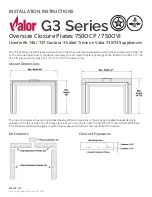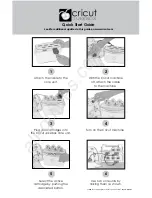
HD(i)-24V-GD-0111-EN
8
CAUTION!
Never put a washer or a nut between the terminal lugs and the 24 volts DC input terminals; this
results in poor conductivity and may cause the inverter to overheat and cause a fire.
Tighten the PVC strain relief nut on the cables until the rubber seal is properly compressed and the cables cannot move. Run the
cables under your cab and cover them with plastic loom (included in our CM series kits) to prevent damage from road debris.
Fasten both cables together every 4 inches with plastic cable ties; try to run both DC (24 volts)
cables as close as possible
together to reduce the risk of interference
(see 6.1) with your television or CB radio. While keeping in mind to allow cables to
move with your cabin air suspension, secure the cables to the chassis from the cabin’s floor to the batteries with several metallic
clamps covered with caoutchouc (included in our CM series kits). These clamps will prevent the cables from being cut or damaged
by the vehicle’ vibrations.
3.7
Connection of the batteries
If you are working with a multiple battery bank, choose a battery with no accessory connected, as it will extend your batteries’ life.
Before going further, it is important to correctly identify the cable connected to the positive terminal of the inverter, and the one
connected to the negative termainal.
The cables must go from the positive terminal of the inverter to the positive terminal of
the battery, and of the negative terminal of the inverter to the negative terminal of the battery. Incorrectly connecting the
battery and inverter will damage your inverter permanently, and is not covered by the warranty.
Always connect the
positive terminals before the negative.
CAUTION!
Reversing the polarity when connecting the DC cables will permanently damage your inverter. THIS
IS NOT COVERED BY THE WARRANTY.
3.7.1
Positive Terminal
Always connect the positive terminals before the negative. Plug the small section of the cable connected to the positive terminal of
the inverter to the positive terminal of the battery, by solidly fixing the terminal with the nut. Without tightening them too much,
the terminals must not be able to move around.
3.7.2
Negative Terminal
The last step is to connect the cable between the negative terminal of the inverter to the negative terminal of the battery, by solidly
fixing the terminal with the nut. Without tightening them too much, the terminals must not be able to move around.
WARNING!
You may observe a spark when making the cable connections since current may flow and charge
capacitors in the inverter. This is normal. Do not make cable connections in the presence of
flammable fumes; it may result in explosion and/or fire.
4
Operation
To operate the power inverter, turn it on by using the ON/OFF switch on the front panel and then by the remote switch (if
equipped). The inverter is now ready to deliver AC 120 volts power to your load. If you are operating several loads from the
inverter, turn them on separately after the inverter itself has been turned on. This will ensure that the inverter does not have to
deliver the starting power for all the loads at once.
4.1
Trouble loads
The waveform of your inverter is called a “Modified Sine Wave.” It is a stepped waveform suitable for most AC loads, designed to
have characteristics similar to sine wave delivered by utility power. Some appliances, however may not adequately filter the
waveform produced by the inverter and could, althow unlikely, be damaged. If you are unsure about powering any device with a
modified sine wave power inverter, contact the manufacturer of the device. None of these potential problems can happen with the
Tundra International pure sine wave inverters (HTS series).































